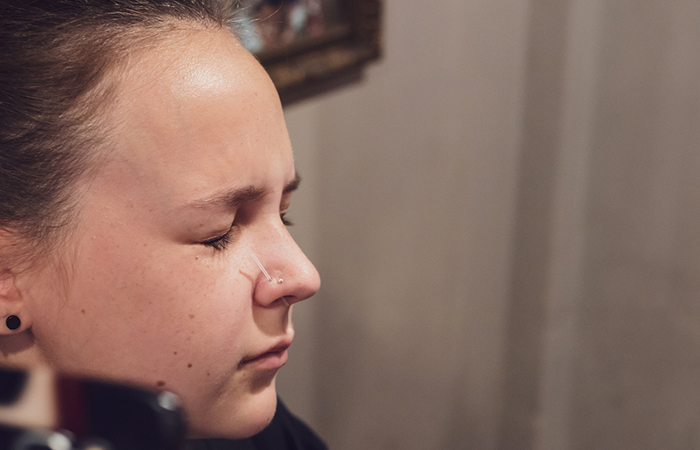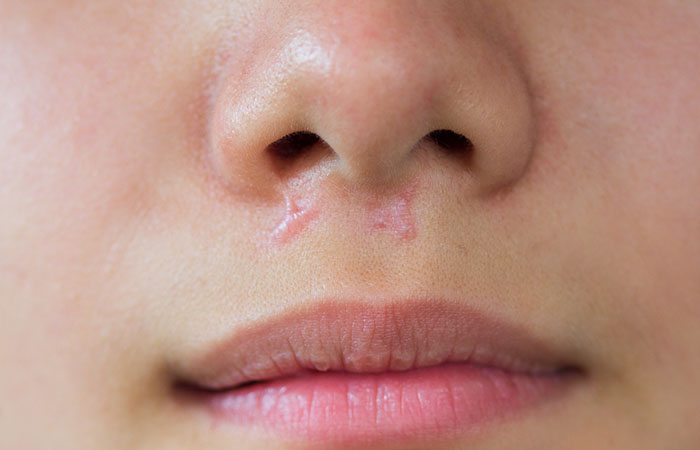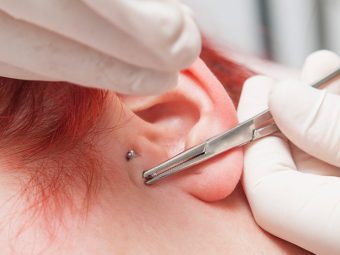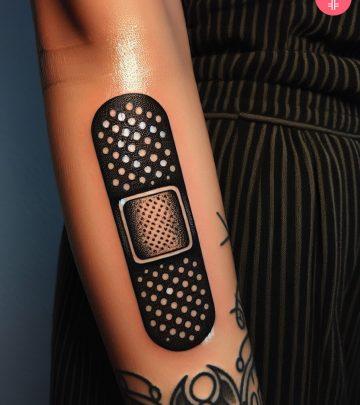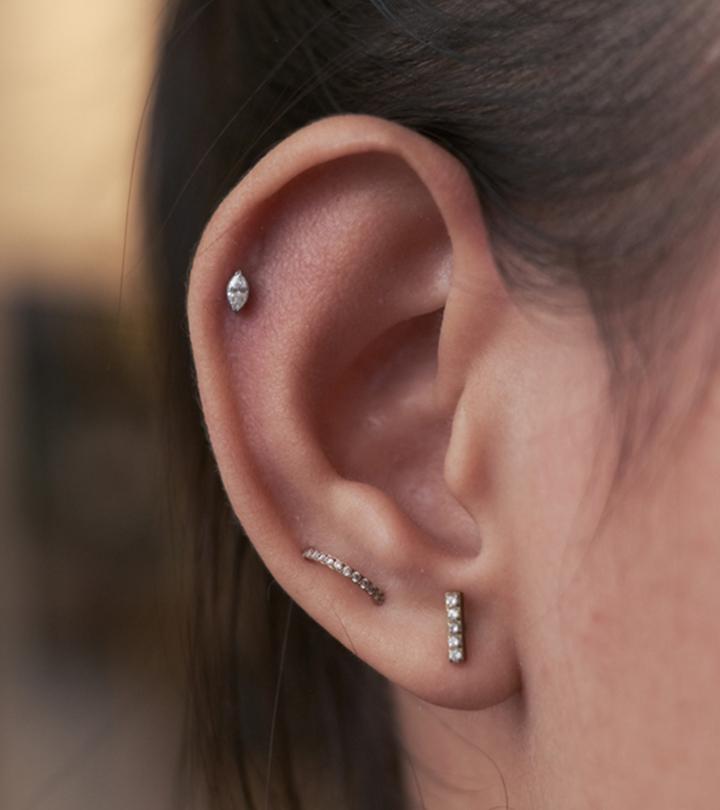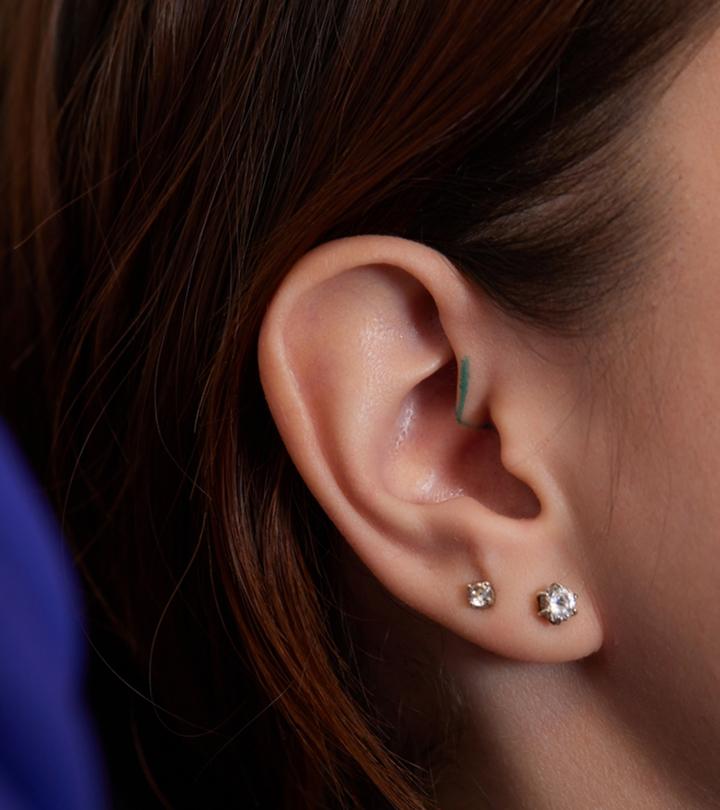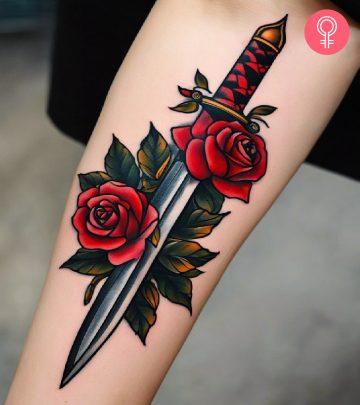Nostril Piercing: Cost, Pain Level, Healing, Aftercare, And Jewelry
Dive into the chic trend of nostril piercings and elevate your style easily!

Image: Shutterstock
Nose piercings have become one of the most popular piercings after, of course, ear piercings. While other types of nose piercings like septum piercing, bridge piercing, or high nostril piercing are considered edgy, standard nostril piercings are more commonly accepted and allowed in most professional settings, making them popular among ladies from all spheres of life. Whether you opt for a dainty nose ring or a cute nose pin, they are sure to elevate your style and enhance your look. A nostril piercing is placed on the soft cartilage over the nasal passage and comes with its own set of challenges and aftercare procedures. If you are considering getting one, get all the deets before actually going for it. Keep reading to learn more!
 Piercing Guide: Nostril Piercing
Piercing Guide: Nostril Piercing- Placement: The side of the nose
- Best Jewelry: Nose studs, rings
- Cost: $35 to $80
- Pain Level: Moderate
- Healing Time: 2 to 4 months
In This Article
How Painful Is Nostril Piercing?

Nostril piercing pain is comparatively lesser than that of a septum piercing or ear cartilage piercing, but it all comes down to an individual’s pain tolerance. People generally feel the pinch, and the actual piercing process is over before you know it. However, nostril piercing is a needle going through cartilage over the bone of your nose, so it will hurt more than getting a piercing on softer areas like an ear lobe.
Lauren, a blogger, shares her experience of getting her nose pierced in her blog. She says she wasn’t sure about getting a nose piercing a while back but she found it completely worth the pain. She adds, “It hurt as much as you would expect a needle being shoved through your nose would hurt, but it wasn’t PAINFUL. I’d give it maybe a 5/10 (i).”
Besides enduring the pain during piercing, you should also be aware of the healing time and process. Let us learn more about it in the next section.
Nostril Piercing Healing Time
The functions of our nostrils include passage of air, humidification, and filtration. It is an area that is exposed to the outside germs and also has bacteria inside. This is why a piercing takes about 2-4 months to heal (1). Also, the exterior of a nose piercing usually heals faster than the interior, so it is always a good idea to talk to a professional piercer before removing or changing the jewelry.
 Trivia
TriviaHowever, the healing time varies from person to person depending on an individual’s health, hygiene routine, and aftercare routines. On that note, check out the next section to learn more about aftercare for your nostril piercing.
Nostril Piercing Aftercare

Follow the aftercare steps suggested by your professional piercer. This way you might be able to accelerate the recovery time of your piercing. Here are a few things you may do to ensure proper healing (2):
1. Avoid Touching
Try to touch your piercing as little as possible as it is very easy to infect your piercing with germs in your hand or those already present in the area. Only touch your piercing after properly washing or sanitizing your hands for cleaning.
2. Clean Timely
Your nose piercing needs to be washed or cleaned at least 2-3 times a day with sea salt solution to avoid the potential risk of infection. It will be even better if you soak your piercing for one minute a day in the sterile saline solution.
3. Avoid Moving The Jewelry
Refrain from twisting, or rotating the nose piercing jewelry as it may hamper the healing and introduce new germs into the piercing potentially leading to symptoms of infection such as redness, smelly discharge, or tenderness.
4. Skip Makeup
Avoid applying makeup products like foundation or primer while your piercing is still new as the chemicals used in certain products may irritate the skin around the piercing location and delay the healing process.
5. Visit Your Piercer
At any time if your piercing looks weird, there is a foul-smelling discharge, or your jewelry gets broken, visit your piercer to make sure everything is alright.
Ensuring appropriate aftercare for nose piercings is crucial for the healing process as well as for estimating the total cost of the procedure in terms of money and time spent on maintenance. Scroll down to find how expensive these piercings are in the next section.
How Much Does A Nostril Piercing Cost?
A nostril piercing is not an expensive affair. However, it depends on your piercing location, the experience of the piercer, the studio or salon’s reputation, and the kind of jewelry that you opt for. You can get a nostril piercing for anywhere between $35-$80 in reputable piercing salons.
However, if you are getting premium treatment and are sure of the salon’s quality services and hygiene, there is nothing wrong with a little splurge for safety and satisfaction.
 Did You Know?
Did You Know?The cost of a nostril piercing naturally affects the choice of jewelry for the piercing, since personal taste and quality blend with affordability to enhance the adorned look. Scroll down to find out different types of nostril piercing jewelry.
Nostril Piercing Jewelry
The overall experience of your piercing and its healing process is significantly influenced by the type, material, and size of the chosen jewelry, as well as when you opt to remove or change it. It’s important to learn about the specifics of the major nose piercing jewelry options and assess their suitability for the piercing before making a final decision on type or material.
Types Of Jewelry
1. Nose Studs

Studs are a common type of nose jewelry and a go-to option for people going for their initial piercings. Twist studs are considered the best as they remain in place and are comfortable. You can add a diamond, a captive bead, or any gemstone of your choice for some sparkle.
2. Hoops
Hoops or simple rings are also a popular choice because they sit nicely on the nose and are appropriate for even formal settings without being too noticeable. You can also opt for faux hoops that come in a C-shape and do not fully close.
3. Nostril Screws
Nose screws or a fishtail are one of the toughest nose jewelry to carry in a fresh piercing. They may fall out as they are often loose or poke you with the thin wires. It is better to leave for when your piercing has healed.
Tips To Choose The Right Material And Size
- For the piercing, opt for implant-grade materials like titanium, niobium, or surgical steel (free from nickel) as they promote healing and do not irritate the pierced skin. Titanium is very rarely linked to allergies, and it has corrosion resistance properties, whereas nickel which is commonly used in stainless steel may cause allergic reactions (3), (4).
- After complete healing, you may go for materials of your choice like 14K gold, silver, platinum, etc. However, if you have any metal allergies, it is better to stick to titanium or niobium.
- Standard piercing is done with an 18 gauge (1.0mm) stud, however, consult an experienced piercer for recommending proper gauze size depending on your nose thickness and other factors.
- Although 6mm to 8mm is the common length of studs, allow a professional piercer to recommend a size so that it fits snugly and does not pinch your nostril.
- Opt for slightly bigger nose jewelry initially to allow room for healing and accommodate any swelling that may happen.
When And How To Change The Jewelry
You should only change your jewelry after your piercing has fully healed as it may infect or irritate the piercing if you try to change it during the healing period. It is recommended to wait for 4-6 months before you attempt to remove your nose jewelry.
Follow the steps below while changing your jewelry after it has healed-
- Wash your hands with soap and water and sterilize your new jewelry.
- Gentle hold your jewelry at the base, unscrew the ball or gem, or open the clasp, and remove the jewelry.
- Gently clean the piercing inside out with a saline solution and then rinse with water.
- Line up the end of the jewelry with the piercing hole and carefully screw the ball of the stud or gently clasp the hoop.
Examining the various options of nostril piercing highlights how important it is to understand the possible risks connected to this type of body modification. Scroll to the section below for more information.
Risks Of A Nostril Piercing
However popular, a nose piercing is a hole through your nose that disturbs the cells and tissues in the area and takes time to heal. Like any wound healing, there are certain risks associated with a nose piercing and some of them are given below (5):
1. Pain
Pain is obvious during a piercing, however, if it does not subside or the pain level increases after 2-3 days of the actual piercing, consult your piercer or medical professionals.
2. Infection
Piercing infections are common and can be tackled easily. Additionally, the nasal passage is rich in bacteria which further increases the risk of infection, which includes a runny nose.
3. Scabbing
Scabbing or crusting is a part of the normal healing process of a piercing. While not posing a serious health risk, it may temporarily affect the appearance of your face.
4. Allergic Reactions
Redness, blistering, or oozing are signs of infection that can occur if you are allergic to the jewelry material you are wearing. It is advisable to check for metal allergies and use safe material jewelry.
5. Keloids
Keloids or nose bumps are large, protruding scars that can happen in case of improper piercing or aftercare during the healing period (6). Look out for any thickening tissues and consult your doctor.
Nose piercings are one of the most conventional piercings to get. They are becoming increasingly mainstream because of the lower pain levels and scope for getting creative with jewelry choices. Nostril piercings usually take about 3-4 months to heal. While they are prone to infection, you can keep your piercings safe by adhering to the aftercare instructions shared by the piercing professional. Also, if you are allergic to certain metals, discuss that with the piercing expert to minimize the risk of allergic reaction and piercing rejection. Taking these small but important measures will ensure your piercing heals properly.
Frequently Asked Questions
What is the scientific reason for nostril piercing?
While there is no concrete proof of the potential benefits of a nose piercing, it has some historical significance and religious status, and it is believed that this type of piercing on the left nostril can stimulate certain acupuncture points and help reduce menstrual pain levels.
Can I go swimming with a new nostril piercing?
It is not advisable to go into swimming pools with a new nostril piercing as it can increase infection risk and irritation. It may also stretch the healing time.
Key Takeaways
- Nostril piercings are among the most popular body piercings with various jewelry options suitable for different people such as nose studs, hoops, screws, curved barbells, and more.
- This type of nose piercing is done on nose cartilage so, it is a little more painful than the ones on soft areas.
- Depending on the salon, your piercing location, and the piercer, a nose piercing‘s cost may vary.
- The type of jewelry material, aftercare routine, and other factors often govern the healing time of a piercing.
If you are looking for more information on nostril piercings, the video below will serve as a comprehensive guide to nostril piercings with the procedure, healing, aftercare, pros and cons, and much more. Check it out!
Personal Experience: Source
StyleCraze's articles are interwoven with authentic personal narratives that provide depth and resonance to our content. Below are the sources of the personal accounts referenced in this article.
(i) My Nose Piercing Experience | The First Weekhttps://whatlaurendidtoday.blogspot.com/2015/07/my-nose-piercing-experience-first-week.html
References
Articles on StyleCraze are backed by verified information from peer-reviewed and academic research papers, reputed organizations, research institutions, and medical associations to ensure accuracy and relevance. Read our editorial policy to learn more.
- Body Piercing
https://youngwomenshealth.org/guides/body-piercing/ - Suggested Aftercare Guidelines For Body Piercings
https://safepiercing.org/wp-content/uploads/2020/04/APP_Body-Aftercare_2023.pdf - Prevalence of Titanium Hypersensitivity in Patients with Titanium Implants: A Systematic Review and Meta-analysis
https://www.ncbi.nlm.nih.gov/pmc/articles/PMC8686894/ - Management of contact dermatitis due to nickel allergy: an update
https://www.ncbi.nlm.nih.gov/pmc/articles/PMC3047925/ - Body Piercing Infections
https://www.ncbi.nlm.nih.gov/books/NBK537336/ - Common complications of body piercing
https://www.ncbi.nlm.nih.gov/pmc/articles/PMC1071670/







